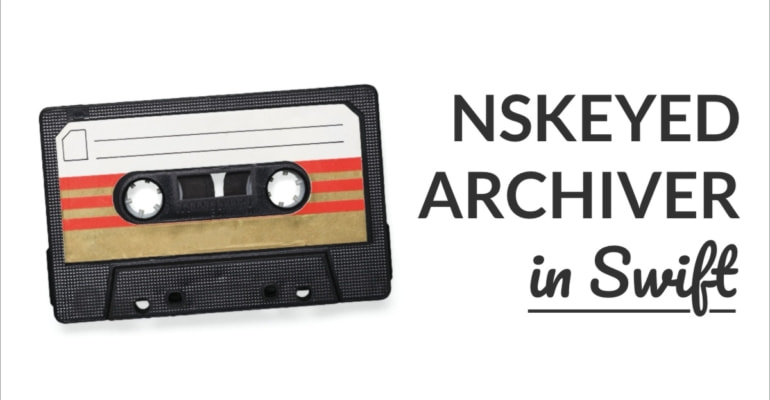Storing Data with NSCoding and NSKeyedArchiver

You can use NSCoding and NSKeyedArchiver to save and load simple data objects with Swift. It’s perfect for scenarios when you don’t need a more complex tool, like Core Data or Realm.
In this tutorial, we’ll discuss:
- How to store and retrieve data objects with
NSKeyedArchiver - Why
NSCodingis an important component in iOS development - How
NSKeyedArchivercompares to components likeCodable - Essential app development principles like serialization
- A whole lot of fun code examples for you to play with
Ready? Let’s go.
- What’s NSKeyedArchiver?
- Adopting NSCoding in Swift
- Working with NSKeyedArchiver
- Saving and Archiving Data
- Loading and Unarchiving Data
- Further Reading
What’s NSKeyedArchiver?
You use the NSKeyedArchiver, and it’s sibling NSKeyedUnarchiver, to serialize Swift data objects, like classes, in an architecture-independent binary file. You can also deserialize them to read the data back.
The NSKeyedArchiver is closely related to components like Codable, plists, User Defaults and even JSON. They’re all components that help you transform Swift’s native classes to something you can store in a file or transmit over the internet. When you think about it, all an app does is store/send data (and give access with a UI).
The name “NSKeyedArchiver” already tells you a bit about what it does:
- You’ve got “NS”, which stands for NeXTSTEP – a hint to iOS’s past – and a designation of Objective-C components.
- Then, “Keyed” means that we’re going to store and retrieve data by key, kinda like the key-value pairs you add to a Swift dictionary.
- Finally, “Archiver” and “Unarchiver” explains what the component does: archiving a bunch of data as a whole, like a
.zipfile but without the compression.
The NSKeyedArchiver component makes use of the NSCoding protocol. It’s similar to Codable, in the sense that, when your class conforms to NSCoding, it’s suitable for use with other components that also rely on NSCoding, like NSKeyedArchiver. It’s a go-between that structures the data.
Let’s dive into saving and loading data objects with NSKeyedArchiver and NSCoding! We’re going to work with the following Swift class:
class Book {
var title:String
var author:String
var published:Int
init(title: String, author: String, published: Int) {
self.title = title
self.author = author
self.published = published
}
}
We’ll load and save the following array of books:
let books = [
Book(title: "Nineteen Eighty-Four: A Novel", author: "George Orwell", published: 1949),
Book(title: "Brave New World", author: "Aldous Huxley", published: 1932),
Book(title: "Mona Lisa Overdrive", author: "William Gibson", published: 1988),
Book(title: "Ready Player One", author: "Ernest Cline", published: 2011),
Book(title: "Red Rising", author: "Pierce Brown", published: 2014)
]
Let’s get a move on!
Adopting NSCoding in Swift
Before we can save and load data with NSKeyedArchiver, our Book class needs to adopt the NSCoding protocol. This protocol formalizes the way custom classes, like Book, can be serialized and deserialized.
What’s serialization anyway? It’s simple: when you serialize an object, you convert it from a Swift-only data format to a stream (or “series”) of bytes. The format-agnostic bytes can then be transmitted as ordinary data, like a string of text. At the other end, you deserialize again and recreate the original, native data format.
The NSCoding protocol formalizes this process, so the result is always the same. We’ll need to adopt the init(coder:) initializer, which will construct a Swift object by decoding it, and the encode(with:) function, which will encode a Swift object.
In the previous section, we’ve already created the Book class and given it a memberwise initializer. We’ve also created an array books that contains a few Book objects.
Let’s continue by adding the NSCoding protocol to the class definition, like this:
class Book: NSObject, NSCoding {
···
}
This protocol now indicates that Book adopts the NSCoding protocol. It also subclasses NSObject, a requirement to use NSCoding.
We now need to add the 2 required functions – as per the protocol – to the class:
required convenience init?(coder: NSCoder) {
···
}
func encode(with coder: NSCoder) {
···
}
Quick Tip: Xcode can automatically add the above function declarations to your code. First, add NSCoding to the class definition. Then, when an error appears, click the question mark in the editor, and then click Fix below “Do you want to add protocol stubs?” Neat!
Coding “init(coder:)”
We’ll start with the failable, required, convenience initializer init(coder:). This initializer will be able to construct Book objects from the NSCoder instance that’s passed to it. This is the decoding/deserialization step.
Change the init(coder:) function to reflect the following:
required convenience init?(coder: NSCoder)
{
guard let title = coder.decodeObject(forKey: "title") as? String,
let author = coder.decodeObject(forKey: "author") as? String
else { return nil }
self.init(
title: title,
author: author,
published: coder.decodeInteger(forKey: "published")
)
}
What’s going on here? 3 parts are important:
- The function is a required convenience initializer, so subclasses must override it, it’s not the designated (but convenience) initializer, and it’s failable, i.e. it can return
nil - guard let ensures that the decoded objects aren’t
nil, and optional type casting ensures they’re the expected type - The
self.init(···)call initializes aBookobject using the memberwise initializer we defined earlier
In short, the init(coder:) creates a Book object by retrieving data from the coder object. It’ll decode this data and use it to set the properties of a new Book instance.
You can learn more about specific techniques and syntax, i.e. guard let, by clicking any of the above links. See how far the rabbit hole goes!
Coding “encode(with:)”
Alright, now that we’ve got the decoder set up, let’s write the encoding function encode(with:). Make sure that your encode(with:) function reflects the following:
func encode(with coder: NSCoder) {
coder.encode(title, forKey: "title")
coder.encode(author, forKey: "author")
coder.encode(published, forKey: "published")
}
Easy-peasy! This function encodes the properties of the Book class. Here’s how that works:
- We’re using
NSKeyedArchiverat some point, which we pass aBookobject - The archiver sees we’re conforming to
NSCoding, which is great - It calls
encode(with:)on theBookobject, and passes an instance ofNSCoderto it - Our function calls
encode(_:forKey:)a few times on that “coder” object, so theNSCodingcomponent now knows what data we want to encode
You may be thrown off here by the lack of a return statement in the encode(with:) function. How can it pass data to the coder if it’s not returned by the function?
The only logical explanation here is that the NSCoder object is passed-by-reference into the function (as a class). We’re changing the actual coder object that’s passed into the function, so beyond this function call, those changes persists, because it’s one and the same object.
Neat! We now have a Book class that’s ready to be encoded and decoded with NSCoding, and any component that uses it for serialization, like NSKeyedArchiver. Moving on…
Working with NSKeyedArchiver
The NSKeyedArchiver and NSKeyedUnarchiver components serialize objects that support NSCoding, which you can then write to disk as a simple binary file. At a later point, you can deserialize that same file, use it in your app, make some changes, and write it back. This makes NSKeyedArchiver a simple database tool.
You can archive data, i.e. Swift object to bytes, like this:
let data = try NSKeyedArchiver.archivedData(withRootObject: books, requiringSecureCoding: false)
And you can unarchive data, i.e. bytes to Swift objects, like this:
let books = try NSKeyedUnarchiver.unarchiveTopLevelObjectWithData(data)
There’s a little more to it, though! You can already see it in the above code: NSKeyedArchiver uses requires a so-called root object. You can’t just encode a random bunch of objects; they need to be part of one overarching, root object. In the examples in this tutorial, we’re working with one array of Book objects.
The archiver and unarchiver makes use of the Swift Data type. It’s a wrapper around simple byte buffers, i.e. a bunch of bytes in serial. Whenever you’re working with bytes directly in Swift, you’ll use the Data type.
Getting the File Path
You can write Data to a file on disk, i.e. a file in your iOS app’s documents directory, and read from it, too. Because Swift apps are sandboxed, we can’t just write to any folder on the iPhone. We’ll need to get a handle on a file in the app’s document directory.
Here’s how you do that:
let path = FileManager.default.urls(for: .documentDirectory, in: .userDomainMask)[0].appendingPathComponent("books")
In the above code, path contains a URL object with a reference to a "books" file on the iPhone’s disk. The FileManager.default.urls(for: .documentDirectory, in: .userDomainMask)[0] code returns a reference to the app’s document directory, which is one of the locations where we’re allowed to read/write our own files. This file has no extension.
Saving and Archiving Data
OK, now that we’ve got a file path, let’s write the archived data to it:
let path = FileManager.default.urls(for: .documentDirectory, in: .userDomainMask)[0].appendingPathComponent("books")
do {
let data = try NSKeyedArchiver.archivedData(withRootObject: books, requiringSecureCoding: false)
try data.write(to: path)
} catch {
print("ERROR: \(error.localizedDescription)")
}
Here’s what happens in the above code:
- We’re getting the URL of the book’s file in the app’s document directory
- Within the do-try-catch block, we’re first archiving the
booksarray, turning it into aDataobject - The
dataobject is written to the file atpath - When an error occurs, its description is printed out to the Console
Loading and Unarchiving Data
What’s awesome is that, now that the books array is persisted to disk, we can actually load that and not use the hard-coded books array anymore. Here’s how:
let path = FileManager.default.urls(for: .documentDirectory, in: .userDomainMask)[0].appendingPathComponent("books")
do {
let data = try Data(contentsOf: path)
if let books = try NSKeyedUnarchiver.unarchiveTopLevelObjectWithData(data) as? [Book] {
print(books)
}
} catch {
print("ERROR: \(error.localizedDescription)")
}
Here’s what happens in the code:
- Just as before, we’re getting the URL of the book’s file in the app’s document directory
- Within the
do-try-catchblock, we’re first reading the data from the file and assign it todata, of typeData– the bytes - With
NSKeyedUnarchiverwe’re unarchiving the root object, i.e. the array of books, and assign it tobooks - We’re also using conditional binding and type casting to
[Book]to ensure we’re getting an array of the right type instead of Any? - Just as before, errors are handled and shown inside the
catchblock
Awesome! We can now print out the books using a simple for loop. Like this:
for book in books {
print("\(book.title) -- \(book.author)")
}
// Nineteen Eighty-Four: A Novel -- George Orwell
// Brave New World -- Aldous Huxley
// ···
At this point, we could append another book to the books array, and by the same route as before, save the books back to the file with NSKeyedArchiver. This makes NSKeyedArchiver / NSKeyedUnarchiver / NSCoding a legit, simple database tool. Awesome!
Further Reading
In this tutorial, we’ve discussed how you can save and load simple Swift objects with NSKeyedArchiver.
We’ve looked at how to implement NSCoding and why, and how you can read from and write to files on disk. We’ve tied it all together by archiving an array of Book objects, and subsequently unarchiving it again. Neat!
Here’s a quick summary for loading and saving data with NSKeyedArchiver.
Preparation
First, make sure that your Swift class implements the NSCoding protocol and subclasses NSObject. Then, get a reference to a file on disk with FileManager.
Loading data
- Read the bytes from the file with
let data = Data(contentsOf: ···) - Get the objects with
NSKeyedUnarchiver.unarchiveTopLevelObjectWithData(data)
Saving data
- Convert objects to data with
NSKeyedArchiver.archivedData(withRootObject:requiringSecureCoding:) - Save data to file with
data.write(to: ···)
Want to learn more? Check out these resources:
- Working With Codable and JSON in Swift
- How To: Working with Plist in Swift
- Working with UserDefaults in Swift
- iCloud Key-Value Store with NSUbiquitousKeyValueStore
- Getting Started With Realm Database In Swift
- Getting Started With Realm Database In Swift
- How To Design Your App’s Database
- How to Pick a Tech Stack for Your App
